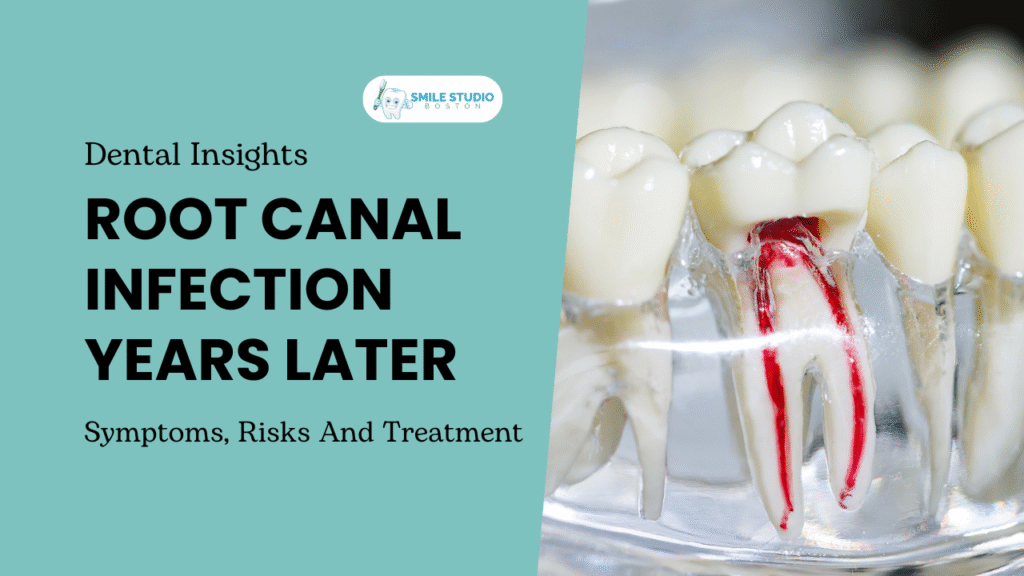I. Is It Common to Have a Root Canal Infection Years Later?
Root canal treatment is a widely successful procedure that helps save teeth affected by deep decay or infection. However, in some cases, a root canal infection can develop years later, leading to discomfort and potential complications. If you’ve undergone a root canal and are now experiencing pain, swelling, or sensitivity, it’s crucial to recognize the signs of a failed root canal and seek timely treatment.
Read More: 6 Signs You Need a Root Canal and What to Do Next
II. Symptoms of a Root Canal Infection Years Later
A root canal infection can remain dormant for years before symptoms appear. Common symptoms of failed root canal years later include:
1. Persistent pain or discomfort in the treated tooth that doesn’t subside.
2. Swelling or tenderness in the gums near the affected tooth.
3. A pimple-like bump on the gums, indicating an abscess.
4. Discoloration or darkening of the tooth due to internal damage.
5. Increased sensitivity to hot or cold foods and drinks.
6. Pain while chewing or biting down.
Read More: Back Molar Extraction: Procedure, Recovery, and Cost
What Does a Failed Root Canal Feel Like?
A failed root canal can cause dull, aching pain or sharp, throbbing discomfort. Some patients report pressure when biting, while others experience swelling and tenderness in the surrounding gums. Is it common to have root canal fail? While root canals have a high success rate, failures can occur various reasons, often requiring retreatment.
Read More: Financial Considerations: Tooth Extraction Vs Root Canal Cost
III. Risks Associated with a Delayed Root Canal Infection
Ignoring an infected root canal can lead to serious oral health issues, including:
1. Spread of infection to nearby teeth or jawbone.
2. Formation of a dental abscess, causing severe pain and swelling.
3. Bone loss around the affected tooth, weakening its foundation.
4. Tooth loss, which may require costly replacement treatments.
If you’re experiencing any failed root canal symptoms, don’t wait to seek professional dental care.
Read More: Root Canal vs. Extraction: Which Option Is Best for You?
IV. Causes of Root Canal Failure Years Later
Several factors can contribute to root canal failure years later, including:
1. Incomplete removal of infected tissue during the initial procedure.
2. Missed or untreated accessory canals allow bacteria to persist.
3. Cracks or fractures in the tooth, making it susceptible to reinfection.
4. Breakdown of the dental restoration, exposing the tooth to bacteria.
5. Persistent bacterial infection, resistant to initial treatment.
6. Poor oral hygiene leads to bacterial buildup and reinfection.
V. Treatment Options for a Failed Root Canal
Non-Surgical Approaches:
1. Root canal retreatment: The dentist reopens the tooth, cleans out the residual infection, and reseals it.
2. Advanced disinfection techniques: Specialized instruments and solutions help remove bacteria more effectively.
Surgical Interventions:
1. Apicoectomy (root-end surgery): The infected root tip is removed to eliminate lingering infection.
2. Tooth extraction and replacement: In severe cases, the infected tooth may be removed and replaced with a dental implant or bridge.
Seeking timely treatment can prevent complications and preserve your oral health.
VI. Preventive Measures
To reduce the risk of a failed root canal, follow these preventive steps:
1. Maintain good oral hygiene, including brushing twice daily and flossing.
2. Schedule regular dental check-ups to detect potential issues early.
3. Address dental problems promptly, preventing them from worsening.
4. Follow your dentist’s aftercare instructions to ensure successful healing.
Start Your Journey to a Radiant Smile with SmileStudio!
A root canal infection years later can lead to discomfort and serious dental complications. Recognizing the symptoms of a failed root canal years later and seeking prompt dental care is crucial for maintaining oral health. Whether you require root canal retreatment or other solutions, a skilled dentist can guide you toward the best treatment option.
At SmileStudio, your smile is our priority! If you’re experiencing symptoms of a failed root canal, don’t wait—early treatment can save your tooth and prevent further complications. Book your appointment today and let our expert team restore your healthy, pain-free smile!
📞 Call Us: +1 (617) 265-5606
📧 Email Us: smilestudioboston@gmail.com
🌐 Visit Our Website: https://smilestudioboston.com/
📍 Find Us: 1428 Dorchester Ave, Dorchester, MA 02122, United States

SmileStudio – Where Beautiful Smiles Begin. Join us on your journey to a healthier, more radiant smile. Book your appointment now!
FAQs
Q. What are the complications of a root canal years later?
A failed root canal can lead to reinfection, abscess formation, bone loss, and even tooth loss if untreated.
Q. How do you treat an old root canal infection?
Treatment options include root canal retreatment, an apicoectomy (removing the root tip), or, in severe cases, tooth extraction.
Q. What is the strongest natural antibiotic for a tooth infection?
Garlic, oregano oil, and clove oil have antimicrobial properties, but professional dental treatment is still essential.
Q. How does an infected root canal affect the body?
A persistent infection can weaken the immune system, cause jawbone damage, and, in severe cases, lead to life-threatening complications.


